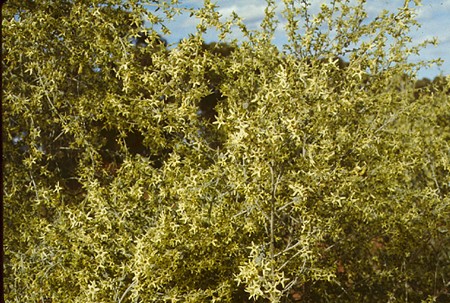 Voucher: Haegi 1351. Photo: L. Haegi © L. Haegi |
 Voucher: Haegi 1351. Photo: L. Haegi © L. Haegi |
 Line drawing by M. Perkins (from L.Haegi, unpubl. thesis). |

Synonymy
Cyphanthera albicans subsp. tomentosa (Benth.) Haegi, Telopea 2: 176 (1981)
Anthocercis albicans var. tomentosa Benth. in DC., Prodr. 10: 192 (1846); Cyphanthera tomentosa (Benth.) Miers, Ann. Mag. Nat. Hist. ser. 2, 11: 379 (1853).
T: On hills near the Macquarie River, A. Cunningham s.n.; syn: BM, K; Interior of New Holland, T.L. Mitchell s.n.; syn: K, MEL.
Description
Erect shrub to 3 m, greyish. Branches granular-tomentose or pubescent with mainly dendritic, non-glandular hairs and scattered glandular hairs.
Leaves elliptic to ovate-elliptic or obovate-elliptic, almost sessile, 5–17 mm long, 3–6 mm wide, tomentose; juvenile leaves to 13 cm long, 4 cm wide.
Inflorescence panicle-like, dense, leafy; pedicels 1–6 mm long. Calyx 2–5.5 mm long, sparsely to densely pubescent. Corolla 8–19 mm long, sparsely to moderately pubescent outside with non-glandular and/or glandular hairs, white, cream or pale yellow, the striations purple; lobes ovate-truncate to almost linear, 3–15 mm long. Stamens 2–5 mm long.
Capsule globose to broadly ellipsoid, 2.5–8 mm long. Seeds 2.3–3.8 mm long.
Distribution and ecology
Occurs only in N.S.W., chiefly on the South Western Plains, with disjunct populations in the Central Tablelands and South Western Slopes. Usually in red sandy-loam in mallee associations; common after fire.
Common name
Grey Ray Flower
Notes
Distinction from other subspecies
Distinct from the other two subspecies by its yellow corolla rather than white or cream and by the close tomentum on the branches and leaves (hairs less than 0.3 mm long).
It is further distinct from subsp. notabilis by the presence of hairs on the outside of the corolla.
Phylogeny
Phylogenetic studies by Garcia & Olmstead (2003) on the Tribe Anthocercideae using two chloroplast DNA regions included this species The studies indicated that Cyphanthera is not monophyletic. Cyphanthers odgersii showed a closer relationship to Grammosolen while the rest of the Cyphanthera species combined to form a clade with Duboisia and Crenidium.
Reference: V.F.Garcia & R.G.Olmstead (2003). Phylogenetics of Tribe Anthocercideaea (Solanaceae) based on ndhF and trnL/F sequence data. Systematic Botany 28: 609-615.
Selected specimens
N.S.W.: c. 11 km ESE of Barmedman, L. Haegi 1574 (AD, MEL, MO, NSW, PERTH); c. 8 km W of Weethalle, C.W.E. Moore 3896 (CANB); c. 66 km W of West Wyalong, R.D. Pearce 83 (ADW, BIRM, MO, NSW).
Images and information on web
Further information and images of this species in NSW can be seen on the PlantNET site.
Pharmacology:
A discussion of the tropane alkaloids which occur in Cyphanthera and other Anthocercideae can be found in Griffith & Lin (2000).Ref: W.J. Griffin & G.D. Lin (2000). Chemotaxonomy and geographical distribution of tropane alkaloids. Phytochemistry 53: 627–628.